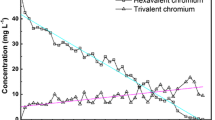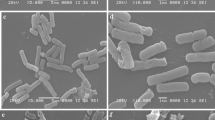Abstract
Environmental contamination by hexavalent chromium, Cr(VI), presents a serious public health problem. This study assessed the reduction of Cr(VI) by intact cells and a cell-free extract (CFE) of an actinomycete, Arthrobacter crystallopoietes (strain ES 32), isolated from soil contaminated with dichromate. Both intact cells and CFE of A. crystallopoietes, displayed substantial reduction of Cr(VI). Intact cells reduced about 90% of the Cr(VI) added within 12 h and Cr(VI) was almost completely reduced after 24 h. The K M and V max of Cr(VI) bioreduction by intact cells were 2.61 µM and 0.0142 µmol/min/mg protein, respectively. Cell-free chromate reductase of the A. crystallopoietes (ES 32) reduced hexavalent chromium at a K M of 1.78 µM and a V max of 0.096 µmol/min/mg protein. The rate constant (k) of chromate reduction was inversely related to Cr(VI) concentration and the half-life (t 1/2) of Cr(VI) reduction increased with increasing concentration. A. crystallopoietes produced a periplasmic chromate reductase that was stimulated by NADH. Results indicate that A. crystallopoietes ES 32 can be used to detoxify Cr(VI) in polluted sites, particularly in stressed environments.
Similar content being viewed by others
References
C. Michel, M. Brugma, C. Aubert, et al., Enzymatic reduction of chromate: comparative studies using sulfate-reducing bacteria, Appl. Microbiol. Biotechnol. 55, 95–100 (2001).
J. McLean and T. J. Beveridge, Chromate reduction by a pseudomonad isolated from a site contaminated with chromated copper arsenate, Appl. Environ. Microbiol. 67, 1076–1084 (2001).
M. E. Losi and W. T. Frankenberger, Chromium-resistant microorganisms isolated from evaporation ponds of a metal processing plant, Water Air Soil Pollut. 74, 405–413 (1994).
A. Ganguli and A. K. Tripathi, Bioremediation of toxic chromium from electroplating effluent by chromate-reducing Pseudomonas aeruginosa A2Chr in two bioreactors, Appl. Microbiol. Biotechnol. 58, 416–420 (2002).
M. A. Mondaca, C. L. Gonzalez, and C. A. Zaror, Isolation, characterization and expression of a plasmid encoding chromate resistance in Pseudomonas putida KT2441, Lett. Appl. Microbiol. 26, 367–371 (1998).
A. H. Alvarez, R. Moreno-Sanchez, and C. Cervantes, Chromate efflux by means of the chrA chromate resistance protein from Pseudomonas aeruginosa, J. Bacteriol. 181, 7398–7400 (1999).
Y. S. Oh and S. C. Choi, Reduction of hexavalent chromium by Pseudomonas aeruginosa HP014, J. Microbiol. 35, 25–29 (1997).
P. Pattanapipitpaisal, N. L. Brown, and L. F. Macaskie, Chromate reduction and 16S rRNA identification of bacteria isolated from a Cr(VI)-contaminated site, Appl. Microbiol. Biotechnol. 57, 257–261 (2001).
P. Wang, T. Mori, K. Toda, et al., Membrane-associated chromate reductase activity from Enterobacter cloacae, J. Bacteriol. 172, 1670–1672 (1990).
D. P. Clark, Chromate reductase activity of Enterobacter aerogenes is induced by nitrite, FEMS Microbiol. Lett. 122, 233–238 (1994).
H. Shen and Y. Wang, Characterization of enzymatic reduction of hexavalent chromium by Escherichia coli ATCC 33456, Appl. Environ. Microbiol. 59, 3171–3777 (1993).
H. Guha, K. Jayachandran, and F. Maurrasse, Kinetics of chromium (VI) reduction by a type strain Shewanella alga under different growth conditions, Environ. Pollut. 115, 209–218 (2001).
Campos, J., M. Martinez-Pacheco, and C. Cervantes, Hexavalent-chromium reduction by a chromate-resistant Baccillus sp. strain, Antonie Leeuwenhoek 68, 203–208 (1995).
M. Basu, S. Bhattacharya, and A. K. Paul, Isolation and characterization of chromium-resistant bacteria from tannery effluents, Bull. Environ. Contam. Toxicol. 58, 535–542 (1997).
M. E. Losi and W. T. Frankenberger, Chromium-resistant microorganisms isolated from evaporation ponds of a metal processing plant, Water Air Soil Pollut. 74, 405–413 (1994).
F. A. O. Camargo, F. M. Bento, B. C. Okeke, et al., Chromate reduction by chromium-resistant bacteria isolated from soils contaminated with dichromate, J. Environ. Qual. 32, 1228–1233 (2003).
S. Das and A. L. Chandra, Chromate reduction in Streptomyces, Experientia 46, 731–733 (1990).
S. R. Laxman and S. More, Reduction of hevalent chromium by Streptomyces griseus, Miner. Eng. 15, 831–837 (2002).
V. Desjardin, R. Bayard, N. Huck, et al., Effect of microbial activity on the mobility of chromium in soils, Waste Manag. 22, 195–200 (2002).
F. A. O. Camargo, B. C. Okeke, F. M. Bento, et al., Diversity of chromium-resistant bacteria isolated from soils contaminated with dichromate. Unpublished study.
R. Francisco, M. C. Alpoim, and P. V. Morais, Diversity of chromium-resistant and reducing bacteria in chromium contaminated activated sludge, J. Appl. Microbiol. 92, 837–843 (2002).
R. J. Bartlett and B. R. James, Chromium, methods of soil analysis, Part 3, in Methods of Soil Analysis, Chemical Methods, D. L. Sparks, ed., ASA/SSSA, Madison, WI, pp. 683–701 (1996).
M. M. Bradford, A rapid and sensitive method for the quantification of microgram quantities of protein utilizing the principle of protein-dye binding, Anal. Biochem. 72, 248–254 (1976).
S. O. Farrell and R. T. Ranallo, Experiments in Biochemistry: A Hands on Approach, Saunders, Orlando, FL (2000).
C. Cervantes, J. C. Garcia, S. Devars, et al., Interactions of chromium with microorganisms and plants, FEMS Microbiol. Rev. 25, 335–347 (2001).
J. M. Rajwade, P. B. Salunke, and K. M. Pknikar, Biochemical basis of chromate reduction by Pseudomonas mendocina, in Proceedings of the International BioHydrometallurgy Symposium, R. Amils and A. Ballester, eds., Elsevier, New York, pp. 105–114 (1999).
F. A. O. Camargo, B. C. Okeke, F. M. Bento, et al., In vitro reduction of hexavalent chromium by a cell-free extract of Bacillus sp. ES 29 Induced by Cu2+, Appl. Microbiol. Biotechnol, 62, 569–573.
Ohtake, E. Fuji, and K. Toda, Reduction of toxic chromate in an industrial effluent by use of a chromate-reducing strain Enterobacter cloacae, Environ. Technol. 11, 663–668 (1990).
C. H. Park, B. Keyhan, B. Wielinga, et al., Purification to homogeneity and characterization of a novel Pseudomonas putida chromate reductase, Appl. Environ. Microbiol. 66, 1788–1795 (2000).
F. Abe, T. Miura, T. Nagahama, et al., Isolation of a highly copper-tolerant yeast, Cryptococcus sp., from the Japan trench and the induction of superoxide dismutase activity by Cu2+, Biotechnol. Lett. 23, 2027–2034 (2001).
T. Suzuki, N. Miyata, H. Horitsu, et al., NAD(P)H-dependent chromium (VI) reductase of Pseudomonas ambigua G-1: a Cr(VI) intermediate is formed during the reduction of Cr(VI) to Cr(III), J. Bacteriol. 174, 5340–5345 (1992).
Author information
Authors and Affiliations
Rights and permissions
About this article
Cite this article
Camargo, F.A., Bento, F.M., Okeke, B.C. et al. Hexavalent chromium reduction by an actinomycete, Arthrobacter crystallopoietes ES 32. Biol Trace Elem Res 97, 183–194 (2004). https://doi.org/10.1385/BTER:97:2:183
Received:
Accepted:
Issue Date:
DOI: https://doi.org/10.1385/BTER:97:2:183




